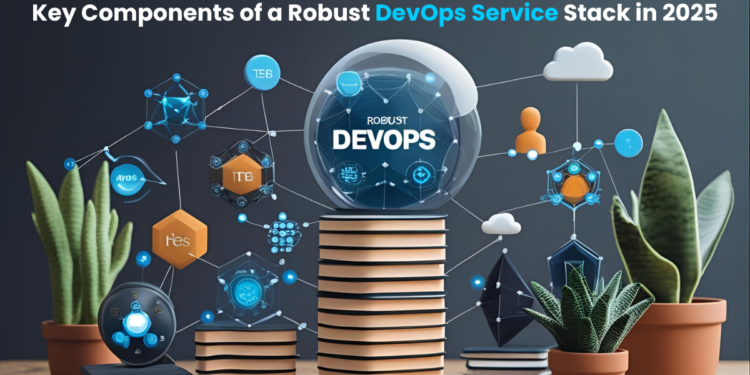In 2025, businesses are under pressure to deliver software faster, with fewer bugs, and with embedded security. The DevOps approach answers this need by promoting collaboration between development and operations teams, automating repetitive tasks, and streamlining software delivery. However, the success of DevOps lies in the composition of its stack—a blend of tools, practices, and culture.
What is a DevOps Service Stack?
A DevOps service stack refers to the complete ecosystem of tools, frameworks, platforms, and services that support the DevOps lifecycle. It includes:
- Development tools (IDEs, version control)
- Automation systems (CI/CD)
- Infrastructure provisioning (IaC, cloud services)
- Monitoring & alerting systems
- Security integrations
This stack ensures end-to-end delivery, from code commit to production deployment and beyond.
Why the DevOps Stack Matters in 2025
The evolution of software delivery requires stacks that:
- Are scalable and cloud-native
- Support multi-cloud or hybrid-cloud environments
- Enable zero-downtime deployments
- Integrate AI/ML for predictive analysis (AIOps)
- Include security and compliance by default (DevSecOps)
DevOps in 2025 is less about “which tool” and more about how well tools work together in an automated, observable, and secure environment.
Core Components of a Robust DevOps Service Stack
1. Version Control Systems
These tools manage source code, track changes, and enable collaborative coding. Git is the industry standard, and tools like GitHub or GitLab offer cloud-hosted repositories.
Key Features:
- Branching & merging strategies
- Code reviews & pull requests
- Integration with CI/CD pipelines
Why it matters: Enables collaboration, traceability, and rollback during issues.
2. CI/CD Pipelines
Continuous Integration and Continuous Deployment tools automate the build-test-deploy cycle.
Key Features:
- Automated code compilation and testing
- Canary deployments and blue-green deployments
- Rollback on failure
Why it matters: Ensures faster and safer releases, reduces human errors, and supports continuous delivery practices.
3. Infrastructure as Code (IaC)
IaC lets you manage and provision infrastructure using declarative configuration files instead of manual processes.
Tools: Terraform, Pulumi, CloudFormation
Features:
- Environment consistency across dev/test/prod
- Version-controlled infrastructure
- Modular templates
Why it matters: Automates infrastructure, supports scalability, and enables repeatable environments.
4. Configuration Management
Used to maintain the desired state of servers and applications after provisioning.
Tools: Ansible, Chef, Puppet
Features:
- Agent or agentless execution
- Task orchestration
- Dynamic inventory support
Why it matters: Ensures application configurations remain consistent, up-to-date, and secure across environments.
5. Containerization and Orchestration
Containers package applications and their dependencies to run reliably across different environments. Orchestrators like Kubernetes handle deployment, scaling, and health monitoring.
Features:
- Stateless and stateful container support
- Self-healing (auto-restarts, replacements)
- Service discovery & load balancing
Why it matters: Increases portability, efficiency, and resilience in deployment.
6. Cloud Integration and Environment Management
DevOps stacks must tightly integrate with cloud platforms to support dynamic environments and elastic resource allocation.
Platforms: AWS, Azure, GCP
Features:
- Auto-scaling groups
- IAM policies for secure access
- Cloud-native service integrations (e.g., S3, Azure DevOps)
Why it matters: Ensures applications are cloud-ready and take advantage of cost-efficiency and scalability.
7. Monitoring and Observability
Essential for understanding the health, performance, and behavior of applications in production.
Tools: Prometheus, Grafana, ELK, Datadog
Features:
- Metrics collection
- Real-time dashboards
- Log aggregation & trace visualization
Why it matters: Helps detect issues early, reduces MTTR, and provides insights for optimization.
8. Security and Compliance (DevSecOps)
Security is no longer an afterthought. DevSecOps practices integrate security scanning and policy checks throughout the pipeline.
Tools: Snyk, Aqua, SonarQube, HashiCorp Vault
Features:
- Static code analysis (SAST)
- Container vulnerability scanning
- Secrets and identity management
Why it matters: Protects against security risks before they reach production, ensuring trust and compliance.
9. Artifact Repositories
Store, version, and distribute application artifacts like Docker images, JAR files, or NPM packages.
Tools: JFrog Artifactory, Nexus, GitHub Package
Features:
- Version control
- Secure access & scanning
- Integration with build systems
Why it matters: Prevents broken builds, maintains artifact integrity, and ensures reproducibility.
10. Collaboration and Incident Management
Tools for real-time communication, incident tracking, and retrospective analysis.
Tools: Slack, Teams, Jira, Opsgenie, PagerDuty
Features:
- Incident alerts with severity levels
- Post-mortem analysis templates
- Integration with deployment logs and monitoring
Why it matters: Boosts coordination during outages, improves response times, and supports continuous learning.
Emerging Technologies Shaping DevOps in 2025
- GitOps: Uses Git as the single source of truth for infrastructure and application delivery.
- AIOps: AI-driven analytics for anomaly detection, prediction, and auto-remediation.
- Serverless CI/CD: On-demand execution of pipeline tasks without managing infrastructure.
- Edge DevOps: DevOps principles applied to geographically distributed edge devices.
- Backstage.io: Developer portals offering unified access to internal tools and services.
Best Practices for Building a Future-Ready DevOps Stack
- Modular Design: Choose decoupled tools that can evolve independently.
- Security Integration: Embed security checks at every stage (shift left).
- Fail-Safe Mechanisms: Implement auto-rollbacks and chaos testing.
- Self-Service Models: Let developers create and manage environments without waiting for ops.
- Unified Observability: Use standardized telemetry for seamless insights across tools.
Conclusion
In 2025, a robust DevOps service stack is critical for scaling engineering velocity, reducing costs, and ensuring reliability. Whether you’re modernizing legacy systems or building cloud-native apps, focusing on these core components ensures your pipeline is secure, scalable, and future-proof.
FAQs
Q1: What is the most critical component in a DevOps stack?
All components are important, but CI/CD pipelines and observability tools are central to automation and reliability.
Q2: Is Kubernetes still relevant in 2025?
Yes. Kubernetes remains the standard for container orchestration, but it’s often abstracted with PaaS or serverless frameworks.
Q3: What is GitOps and why is it important?
GitOps uses Git as a single source of truth to manage infrastructure and applications, enabling declarative, automated deployments.
Q4: How do you future-proof a DevOps stack?
By adopting modular, API-first tools, enforcing security policies, and enabling automated observability across your pipeline.












